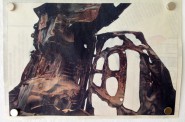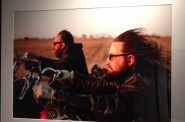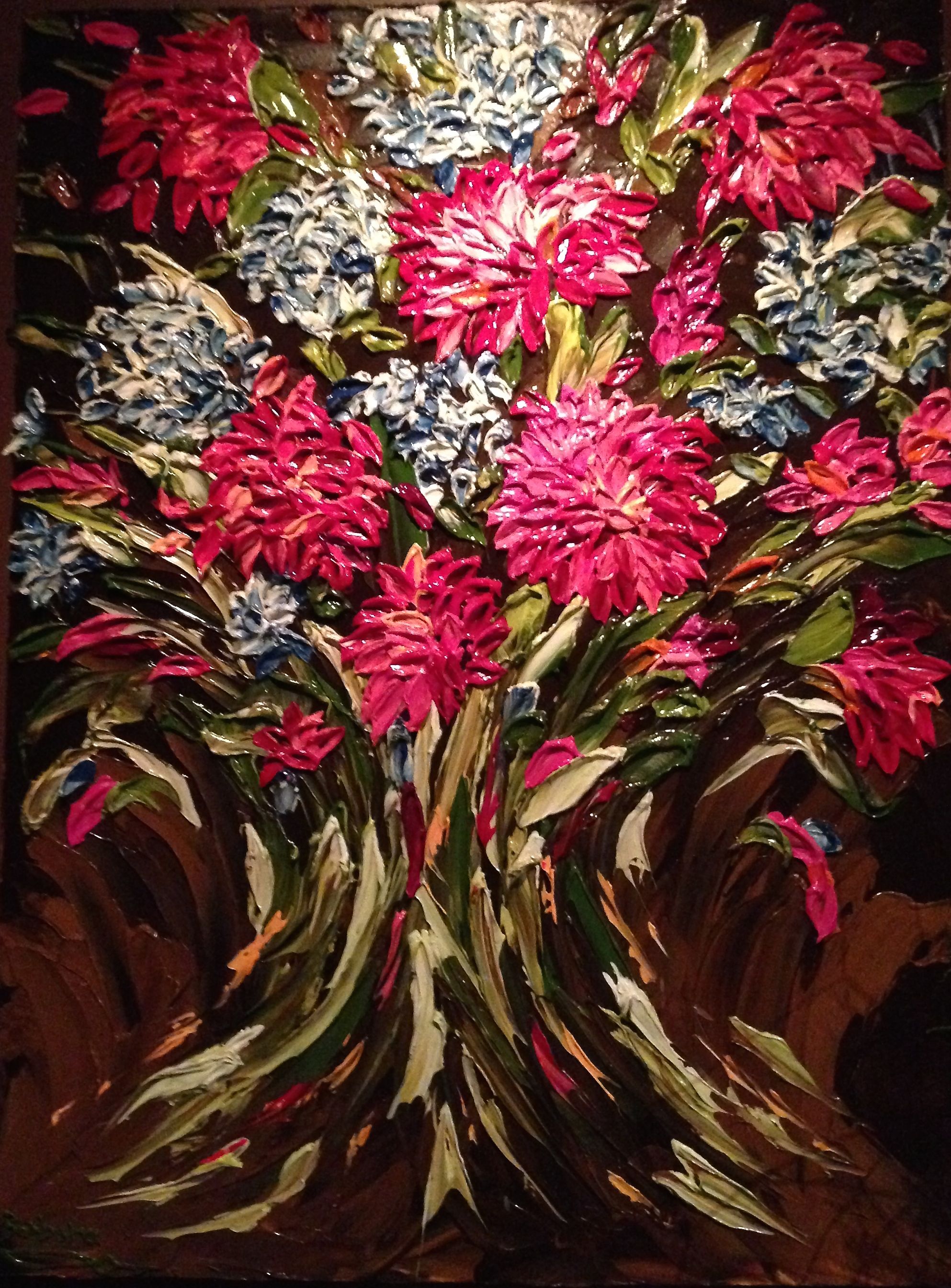Apocalypse Now
Keith Haring’s Apocalypse Series has a vibrant, end-of-the-world quality.
“Skyscrapers scrape rents of blue and white paint from the sky, shredding, peeling, nitrous ochres and red eat through bridges, which fall into the rivers splashing color across – my back I always hear – piers, streets AMOK art. Hurry up please, it’s time.”
Writer William Burroughs utters this recurring refrain in his literary counterpart to artist Keith Haring’s Apocalypse Series, now showing at RedLine Milwaukee. Haring, who died of AIDS complications in 1990, is most well-known for his spirited graffiti work. His drawings moved from the subway tunnels to the art galleries, but he kept a connection to the underground, the subversive and the street. His most characteristic figures are cartoon-like line drawings of crawling babies, dogs, angels and dancers activated by slashing lines of movement. But his Apocalypse Series, as the name suggests, is darker work: more nuanced, detailed, sinuous and sinister.
Haring is similarly energized, and his bright colors have a sharply pained edge. The cursory view of his prints at first feels gleeful, but this is quickly tempered by black silhouettes of haunting, uncertain figures, piles of fragile bodies, and lines pouring down pages like black tears.
Haring occasionally collages images of religious figures in the background who watch over the cacophonous proceedings. The saintly, regal photographs are docile, aloof, unmoved by the plight of the twisting human figures around them. Even the traditions of art, as represented by the Mona Lisa, offer only a locked door when searching for solace. In one piece by Haring, the Mona Lisa is inserted into a composition and enhanced with black x’s over her eyes. She offers no sympathy, there is no comfort in her placid presence. These collaged details, self-assured in their visual perfection and art historical pedigree, don’t have the raw grit and spirit of Haring’s bold lines and gestures. They seem powerless amidst his chaos.
The production of this series in 1988 may also have had another influence. The AIDS epidemic was ravaging New York’s art scene, which
Haring was deeply immersed in, and the disease was a mysterious killer. Desire and death become linked in Haring’s thinly veiled allusions to sex and biology.
Tough stuff, but Haring has such a natural buoyancy in his quality of line and color that while he can take you down into strange depths and you can still come back to the surface. He is an apt Virgil, leading us like Dante on a scenic tour of the underworld.
Keith Haring: The Apocalypse Series continues through July 19 at RedLine Milwaukee (1422 N. 4th Street).
SHORT TAKE
Delightful Shelf-Indulgence
One of the things that Portrait Society Gallery director Debra Brehmer does really well is orchestrate multiple complementary shows throughout her gallery space. The current exhibitions at Portrait Society exemplify this with the recurring presence of that most humble and literally put-upon receptacle of domestic life: the shelf.
It makes a pretty handy device for discreetly focusing our attention. A shelf is a platform of a stage in which objects are actors. Their meaning, purpose, and visual interest is modified by other objects selectively placed in proximity to them.
Keith Nelson is represented by a number of works in the solo exhibition, Arrangements, and joined by 11 other artists in Guest Composers. He is an elegantly minimalist modernist. The things he puts together in largely angular, geometric assemblages all started out with former lives somewhere — packing material, lunch cartons, table tops, what have you. Each is repurposed with an eye for the visual and their ability to contribute to the aesthetic spirit within the group Nelson orchestrates. All done on a shelf, of course.
Arrangements: Keith Nelson and Guest Composers, in addition to Shelfie: A Portrait Society project of self via shelf and Rural Utopia: Watercolors from Blotchy Blobs Blog by J. Shimon continue through July 5. Portrait Society Gallery is located on the 5th floor of the Marshall Building, 207 E. Buffalo Street.
THIS WEEKEND
FRIDAY, MAY 30
Breehan James
233 N. Milwaukee Street
Artist reception 5-7:30pm
Exhibition continues through July 3.
Feeling a little outdoorsy? This might be just the exhibition for you, as the paintings and watercolors of Breehan James evoke the rugged life of a hunting camp and the solitude of wild nature.
SATURDAY MAY 31
Karen Halt: Birds and Beasts of Uncommon Beauty
Marshall Building, 1st Floor
207 E. Buffalo Street
Exhibition closes May 31.
In paint and textiles, artist Karen Halt creates imagery drawn from familiar details, but enhanced by a slightly surrealistic re-imagining of worlds inhabited by animals and people.
Art
-
It’s Not Just About the Holidays
 Dec 3rd, 2024 by Annie Raab
Dec 3rd, 2024 by Annie Raab
-
After The Election Is Over
 Nov 6th, 2024 by Annie Raab
Nov 6th, 2024 by Annie Raab
-
The Spirit of Milwaukee
 Aug 30th, 2024 by Annie Raab
Aug 30th, 2024 by Annie Raab
Art Date
-
Slower Than a New York Minute
 May 16th, 2014 by Kat Murrell
May 16th, 2014 by Kat Murrell
-
Easy Rider
 May 9th, 2014 by Kat Murrell
May 9th, 2014 by Kat Murrell
-
Spring Has Sprung
 May 2nd, 2014 by Kat Murrell
May 2nd, 2014 by Kat Murrell


























This line from the Apocalypse show (in your review), “the freedom that comes from breaking apart and the revelation of all possibilities” is wildly intriguing to me!